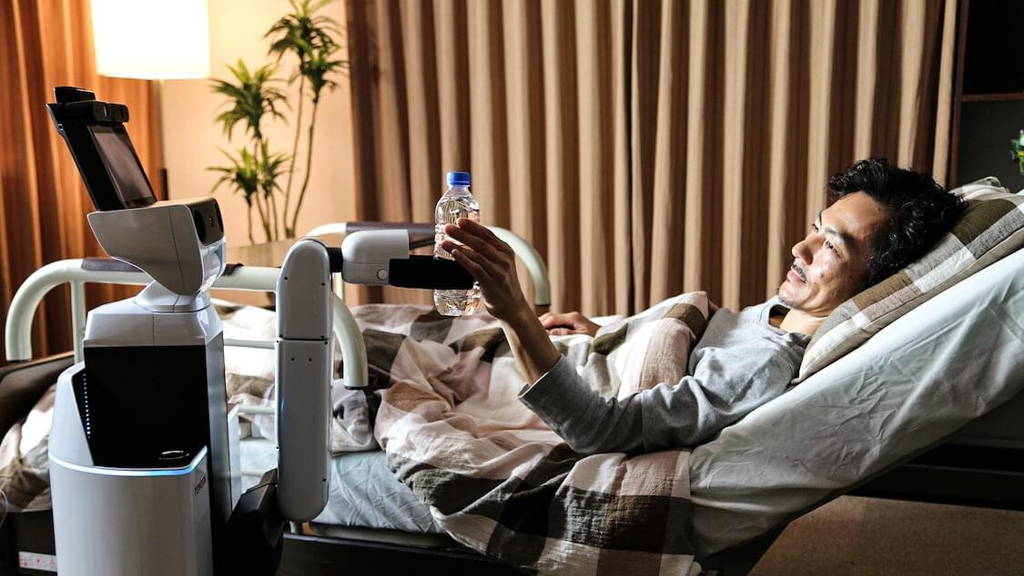Artificial intelligence and robotic technologies have been promising areas for healthcare for years. The explosion of healthcare data combined with the rise in demand from ageing populations around the world, rising costs, and a shortage of supply – both in the number of healthcare professionals needed to treat and care for an increasing number of sick people and the availability and access to a broader range of necessary services than ever before – has left a monumental gap that only technology can fill, consultancy firm PwC writes in the report ‘What doctor? Why AI and robotics will define New Health’.
Technology innovating old treatments
Modern health systems can treat and cure more diseases than ever before. New technology is bringing innovation to old treatments. Yet significant quality, access and cost issues remain and our health systems are becoming increasingly unsustainable.
With this in mind, the PWC report on New Health focusses on the emergence and increasing use of artificial intelligence (AI) and robotics within and throughout this New Health ecosystem. Both technologies will have a significant impact on healthcare systems around the world.
The PWC report looks at the benefits of AI and robots for healthcare professionals and stakeholders like patients and governments. One of AI’s biggest potential benefits is to help people stay healthy so they don’t need a doctor, or at least not as often. The use of AI and the Internet of Medical Things (IoMT) in consumer health applications is already helping people to manage their own healthcare and to keep themselves well through healthier living.
It has become increasingly clear that policy makers, payers, providers, educators and the public need to consider:
- What is the role of the AI/ robot doctor?
- What is the role of the human doctor?
Better at repetitive tasks
Another big benefit is that AI and robotics can perform tasks like sifting through enormous piles of data/scans et cetera much faster, supporting better and earlier diagnostics, or combine data to provide scientists with new insights. AI is already being used to detect diseases, such as cancer, more accurately and in their early stages. Robots can help with or perform tasks like delicate surgery,lift people from their beds or act as social companions.
5 trends where AI, robotics redefine health
There are five distinct trends that will see AI and robotics will define New Health.
1. The value challenge: chronic diseases and an ageing population combined with limited resources, with continuing investments in facilities and equipment that were built to solve a completely different set of healthcare needs and are not designed to cope with this demand.
2. An explosion in the amount of health data that is now available to us. 80% of this extraordinary amount of data is unstructured. Staying current with and being able to access this data is simply beyond the scope of any human individual.
3. Information technology development in healthcare has been rapidly moving from products to services to solutions. Past decades have focused on the innovation provided by medical products delivering historic and evidence-based care. The present decade is one of medical platforms focused on real-time, outcome-based care. The next decade is moving towards medical solutions – using AI, robotics, and virtual and augmented reality – to deliver intelligent solutions for both evidence- and outcome-based health and focusing on collaborative, preventative care.
4. Technology has had an impact far beyond the developments in healthcare. The explosion of technology – digitally enabled, wireless connectivity across increasingly mobile devices – has created an increasing democratisation of access for healthcare. Some of the most powerful AI tools are already embedded in Android or iOS. Harnessing this technology is providing consumers with the data and information they need to proactively manage their own health and wellness, and to make better, more informed decisions in partnership with their healthcare providers.
5.The willingness of the general public to be more active participants in their own health and wellness has now reached critical mass. The explosion of technology and the increasing ubiquity of the Internet of Things (IoT) is bringing about breakthroughs that are erasing healthcare boundaries and enabling care anywhere and everywhere. This willingness is extending into the areas of AI and robotics.
###ALroboticshealthcare###
Some roads where AI and robotics are already having an effect:
Early detection
AI is already being used to detect diseases, such as cancer, more accurately and in their early stages. The proliferation of consumer wearables and other medical devices combined with AI is also being applied to oversee early-stage heart disease, enabling doctors and other caregivers to better monitor and detect potentially life-threatening episodes at earlier, more treatable stages. On the horizon, Microsoft is developing computers programmed for use at a molecular level to start fighting cancerous cells as soon as they are detected.
Diagnosis
80% of health data is invisible to current systems because it’s unstructured. IBM’s Watson for Health uses cognitive technology to help healthcare organisations unlock vast amounts of health data and power diagnosis. Watson can review and store far more medical information – every medical journal, symptom, and case study of treatment and response around the world – exponentially faster than any human.
Google’s DeepMind Health is working in partnership with clinicians, researchers and patients to solve real-world healthcare problems. The technology combines machine learning and systemsneuroscience to build powerful general-purpose learning algorithms into neural networks that mimic the human brain.
Decision-making
Improving care requires the alignment of broad base data analysis with appropriate and timely decisions, and predictive analytics can support clinical decision-making and actions as well as prioritise tasks. Using the system dynamics driven pattern recognition to identify patients at risk of developing a condition – or seeing it deteriorate due to lifestyle, environmental, genomic, or other factors – is another area where AI is beginning to take hold in healthcare.
Treatment
Beyond scanning health records to help providers identify chronically ill individuals who may be at risk of an adverse episode, AI can help clinicians take a more comprehensive approach for disease management, better coordinate care plans and help patients to better manage and comply with their long-term treatment programmes.
Robots have been used in medicine for more than 30 years. From the first programmable universal machine for assembly (PUMA), used in urology surgery in the 1980s, to the da Vinci robot, the most widely used robotic system in clinical use today, robots have developed to perform a wide range of tasks and functions. They range from simple laboratory robots to highly complex surgical robots that can either aid a human surgeon or execute operations by themselves. In addition to surgery, they’re used in hospitals and labs for repetitive tasks, in rehabilitation, physical therapy and in support of those with long-term conditions.
Research
According to the California Biomedical Research Association, it takes an average of 12 years for a drug to travel from the research lab to the patient. Only 1% of the drugs that begin pre-clinical testing ever make it to human testing and just one of these five is ever approved for human usage.
Drug research and discovery is one of the more recent applications for AI in healthcare. By directing the latest advances in AI to streamline the drug discovery and drug repurposing processes there is the potential to significantly cut both the time to market for new drugs and their costs, not only for the labs who develop the drugs, but for those people whose health depends upon them. However, medical research is not just about finding new drugs to combat disease. It also includes research into disease itself, with the ultimate goal being to inoculate against or completely eliminate disease.
Training
AI allows those in training to go through naturalistic simulations in a way that simple computer-driven algorithms cannot. The advent use of natural speech in technology and the ability of an AI computer to draw instantly on a large database of scenarios means AI can respond to questions, decisions or advice from a trainee and can challenge more effectively than a human can. And the training programme can learn from previous responses from the trainee, meaning that the challenges can be continually adjusted to meet their learning needs. To date, the main way new technologies have been used to augment training is through virtual reality (VR). Combining VR with AI will offer boundless opportunities for extending the skills of trainees in a targeted fashion.
Just the beginning
As these technologies develop, faster and better diagnoses, and more effective treatments, will save more lives and cure more diseases, and we will have more opportunities enabled by this technology to live healthier lives. So, whether we like it or not, AI and robotics are the future of healthcare. Access to quality, affordable healthcare, and good health for everyone is the ultimate goal. The economic and social advantages to be gained from integrating AI and robotics seamlessly into our existing healthcare systems, and then create new models of healthcare based on these technologies, are enormous.
Human element
Yet healthcare remains personal, and the human element must remain at its core. This will mean redefining the various roles of healthcare professionals, and ensuring that the necessary new skills are understood and taught in or medical schools.
The public is ready to embrace this new world of healthcare, a survey among people in 12 countries shows. A significant percentage of respondents were highly willing to choose certain treatments, tests or services administered by an AI or robot and there was widespread agreement about these services across the countries surveyed. But a few things need to happen, PwC states, before willingness is translated into reality:
1. For governments:
create quality standards and a regulatory framework which are applicable to and obligatory for the entire healthcare sector, as well as the appropriate incentives for adopting new approaches. Linking regulations to facilities or humans, will naturally inhibit adoption. Also, AI and robotics should be seen as making healthcare more accessible and affordable. There is a risk that these technologies may become the provenance of the well off.
2. For healthcare professionals:
understand how AI and robotics have the potential to work for and with them in a medical setting as well as throughout the healthcare eco-system, and be open to change. If clinicians will not be as good at monitoring, diagnosis, decision making or surgery, then what is the unique role for the human, and how can they prepare for it?
3. For patients and the general public:
become more accustomed to artificial intelligence and robots and discover its benefits for themselves. Although, we suspect just as they have already adopted AI in their everyday lives, health technologies will similarly be taken up with alacrity.
4. For the private sector developing AI and robotics solutions:
and those solutions need to solve the big issues of demand and resource that every health system faces. In essence, by providing AI and robotic driven solutions, the private sector has the
opportunity to disrupt healthcare for the good.
5. For decision-makers at healthcare institutions:
develop an evidence base, measure the success and the effectiveness of the new technology; phased
implementation, prioritise and focus on what consumers want and need.
Innovation from AI and robotics lies at the core of our ability to redefine how we deliver healthcare to our citizens. Digitally enabled care is no longer a nice-to-have, but a fundamental imperative for governments and business to reinvent how healthcare is accessed and delivered. This is creating unprecedented opportunities to transform what has been provision of healthcare that is traditionally focused on the clinician, the hospital, their legacy infrastructure, and incentives to maintain the status quo. AI and robotics are the next wave in this transformation.







